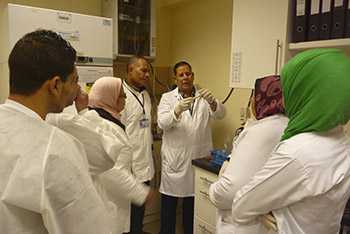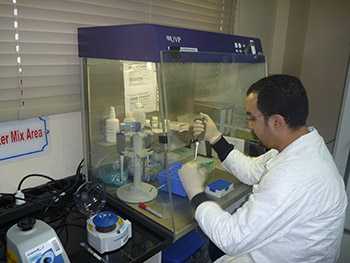Decentralizing and Strengthening Egypt’s Surveillance Lab System
“Lab decentralization cuts the central lab’s workload, increases biosafety and biosecurity, and improves the quality and efficiency of surveillance to better protect the population from disease threats.”
— Dr. Adel Mansour, Medical Scientist, International Emerging Infections Program, Damanhur, Egypt.

The importance of lab surveillance to protect public health cannot be overstated; when one lab is recognized as a model for other labs, it deserves a closer look.
For example, Egypt’s population-based surveillance lab is part of the International Emerging Infections Program (IEIP) in Damanhur, a city in the western Nile Delta. The Ministry of Health and Population (MoHP) plans to “copy and paste” the IEIP lab model across the Delta, and to also expand lab capacity in other Egyptian governorates—a critical step in controlling diseases like influenza, pneumonia, arbovirus, hepatitis and meningitis. It’s also an example for decentralized labs.
CDC and MoHP established the IEIP in 2005 to support Egypt’s disease surveillance and response. It’s part of the larger IEIP program that’s helping 14 Middle Eastern and West African countries build capacity in surveillance, laboratory diagnostics, and data management to meet International Health Regulations.
Components of a Successful Surveillance Laboratory
Egypt’s population is growing faster than any other country in the Middle East, increasing the demand for skilled public health professionals and strong laboratory systems, like Egypt’s national reference lab - the Central Public Health Lab (CPHL) - and its supporting subnational laboratories.
The IEIP lab success rests on carefully constructing standardized surveillance and incorporating key components of a targeted surveillance system—basic laboratory diagnostics, high-quality data, and investment in human capital, which are detailed below:
- A targeted surveillance system. The IEIP lab tracks, investigates, and identifies targeted, common diseases, serving as an early warning system to prevent outbreaks. Surveillance covers acute febrile, respiratory, and influenza-like illnesses, as well as acute infectious neurological and diarrheal diseases. The lab is working to include surveillance for tuberculosis.
- Basic laboratory diagnostics. In 2009, IEIP quickly detected the early stage of an H1N1 outbreak because it used the lab diagnosing flu cases locally, instead of using the CPHL located 160 miles away in Cairo. The lab could do this because it had expanded capacity to meet biosafety standards. It can also conduct basic bacteriology, serological, and molecular diagnoses.
- High quality data. Dealing with over 100,000 records—both paper and electronic—is a challenge for any lab. IEIP data management team’s innovation created gold-standard data quality. The team developed software to streamline and improve data collection, analysis, and archiving. Their efforts helped reduce staff data management hours and produced more accurate and faster reporting and response times.
- Investment in human resources. Understanding the importance of a trained public health workforce, the IEIP is providing trainings that cover surveillance systems, lab quality management systems, scientific writing, research ethics, biosafety cabinet certification, and outbreak investigations.

This year alone the IEIP held 19 different trainings for 341 participants from Egypt and other countries; course participants included lab staff, physicians, nurses, residents in CDC’s Field Epidemiology Training Program, and MoHP staff. Plans are in the works to expand these efforts through a train-the-trainer program.
A Model for Egypt Labs
The IEIP lab has become a Center for Public Health Training and Capacity Building. In addition to developing Egypt’s public health workforce, the site hosts international visitors who are working to put similar surveillance models in their own countries. IEIP’s mentorship will be a great asset when Egypt becomes one of five Regional Coordinating Centers supporting the newly established Africa Center for Disease Control (CDC).
Related Links
- Page last reviewed: December 12, 2016
- Page last updated: December 12, 2016
- Content source:


 ShareCompartir
ShareCompartir